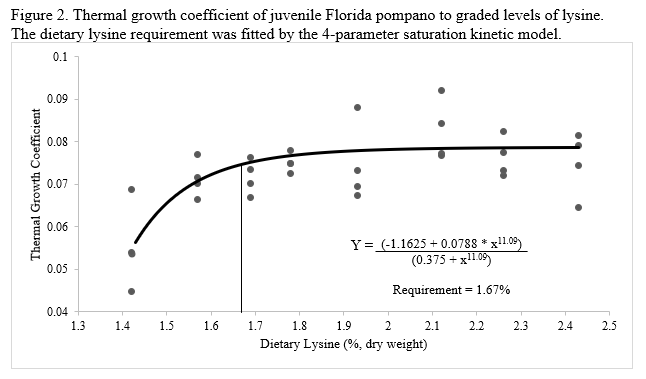QUANTITATIVE LYSINE REQUIREMENT FOR JUVENILE FLORIDA POMPANO Trachinotus carolinus FED PLANT-BASED DIETS
Florida pompano, Trachninotus carolinus is positioned to be an important fish species in US mariculture. If commercial production is to be developed sustainably and with reduced feed costs, it is critical to maximize the level of plant-based proteins in the diet. Thus, good information is needed first on limiting amino acids, which would include lysine. This work was conducted using eight diets formulated with graded levels of lysine (1.42-2.42% dry weight) and fed to juvenile pompano (mean initial weight 13.07 ± 0.46). Dose responses and significant effects were observed in final weight (FW), percent weight gain (PWG), thermal growth coefficient (TGC) and feed conversion ratio (FCR). Significant differences in mean fish whole body amino acids were observed in aspartic acid, glutamic acid, isoleucine, leucine, lysine, methionine, phenylalanine, threonine, tyrosine and valine. Regression models, such as broken-quadratic model (BQM), 4-parameter saturation kinetic model (4-SKM), 5-parameter saturation kinetic model (5-SKM), one-slope broken line model (BKL.1) and two-slope broken line model (BKL.2) from R were fitted against different parameters to determine the dietary lysine requirement. Thermal growth coefficient was the parameter utilized to fit a 4-SKM model and determine the quantitative lysine requirement. Based on these results, a minimum lysine requirement of 1.67% dry weight is recommended for practical feed formulations.
